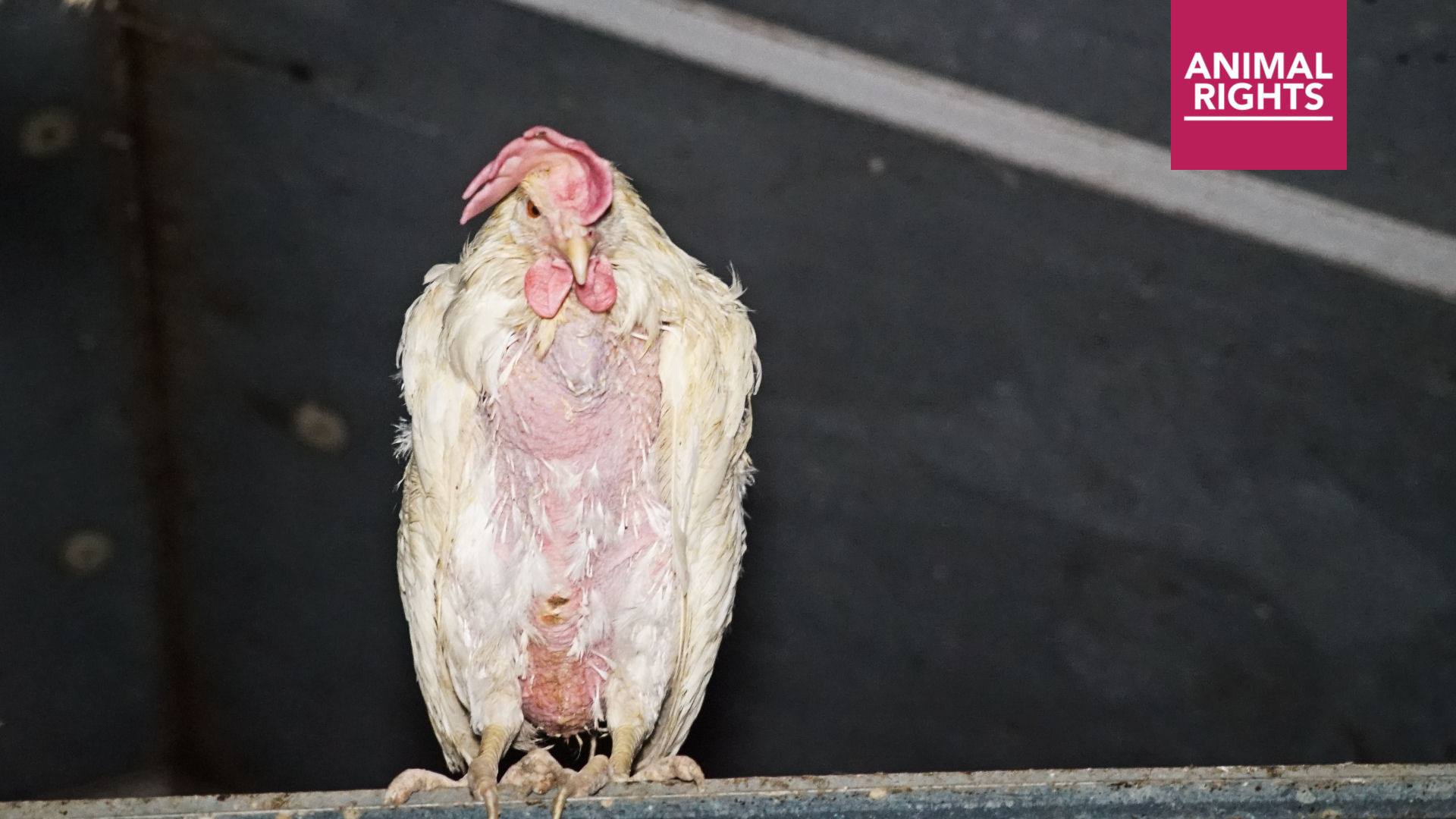Il Partito per gli Animali forza un grande dibattito sulla sofferenza degli animali nell’industria del bestiame
On the Party for the Animals’ (PftA) insistence a big debate will be held in the Dutch Lower House on the suffering and dying of animals in the livestock industry. PftA’s parliamentary leader Esther Ouwehand: “A radical change of course is needed, involving a transition to an agriculture in which we do justice to animals.”

A chicken in a Dutch “horror stable” (picture by Animal Rights)
The debate will be held on the 24th of January next. The Dutch Party for the Animals wants to use this debate to force the Minister of Agriculture and colleague politicians to take a good look at themselves: when is the line crossed in terms of animals suffering in the livestock industry?
Several reports show structural malpractices in Dutch livestock farming. Last week it appeared that sows are so severely overbred to farrow as many piglets as possible that millions of piglets are suffering badly in the maternity barn. Ten years ago, the sector promised to push back piglet mortality, but those figures only grew after that. Additionally, the air in pig barns is so poisonous that more than half of the pigs in the Netherlands catch pneumonia.
The animal rights organisation Animal Rights recently published a series of videos of Dutch barns. Those prove that the reality for animals is completely different than what the livestock industry, supermarkets and government make it look like: bald and weakened chickens, which can hardly walk, among dead species in barns. Piglets and their mothers live above their own excrements on a concrete slatted floor in unfurnished, often dirty cages. The Association of Dutch Veterinarians ‘Caring Vets’ confirms that these type of practices are no exception but normal in everyday life in the livestock industry.
Esther Ouwehand of the Party for the Animals wants to have some crucial questions answered in the coming debate: “The key question is: How can those practices be legal? The follow-up question is: If this is legal, why are people not allowed to see it? Certainly if you make the customer responsible, you have the duty to inform them truthfully and completely about where their animal products come from. For that reason, the Minister must 1) acknowledge that there is a gigantic gap between the picture presented and reality in livestock farming and 2) to distance herself from the tactics of the sector to criminalise messengers such as Animal Rights. The right to information is a core value in a democracy.”
Poiche’ il Partito per gli Animali abbia insistito, sara’ tenuto nella Camera olandese un grande dibattito sulla sofferenza e la morte degli animali nell’industria del bestiame. Leader del partito Esther Ouwehand dice: “Ci vuole un cambio radicale ed una transizione verso un’agricoltura dove si rispettano i diritti degli animali.”

Una gallina in una stalla “horror” (foto di Animal Rights)
Il dibattito avra’ luogo il 24 gennaio di quest’anno. Il Partito per gli Animali olandese vuole che tramite questo dibattito il ministro dell’agricoltura e gli altri politici si chiederanno: quando avremo raggiunto il limite per quanto riguarda la sofferenza degli animali nell’industria del bestiame?
Esistono vari report che evidenziano l’esistenza di errori strutturali nel settore del bestiame olandese. La settimana scorsa infatti si e’ scoperto che i maiali sono stati allevati appositamente e in modo esagerato in modo da produrre piu’ maialini possibile, di conseguenza milioni di maialini crepano subito dopo la nascita. Dieci anno fa, il settore aveva promesso di ridurre il numero di maiali morti, ma in questi diec’anni questo numero e’ solo aumentato. Inoltre, l’aria nelle stalle dei maiali e’ cosi velenosa, che oltre la meta’ dei maiali nei Paesi Bassi soffre di pulmonite.
L’organizzazione per i diritti degli animali Animal Rights ha pubblicato recentemente una serie di immagini dalle stalle olandesi. Queste immagini dimostrano chiaramente che la realta’ degli animali e’ completamente diversa da quella che il settore del bestiame – insieme ai supermercati e il governo – racconta ai consumatori. Cioe’, le galline sono senza piume ed indebolite e riescono malapena a camminare in mezzo ad altre galline morte nella stalla. I maialini e le loro madri vivono sui loro escrementi sopra a delle grate in gabbie spoglie, spesso sporche. L’associazione dei veterinari Caring Vets conferma che queste pratiche non sono eccezionali, ma piuttosto una normale pratica nell’industria del bestiame.
Nel dibattito, Esther Ouwehand del Partito per gli Animali vuole ottenere delle risposte su alcune domande importanti: “la domanda principale e’: perche’ queste pratiche sono legali? La prossima domanda e’: se cio’ e’ legale, perche’ la gente non puo’ vederlo? Soprattutto se rendi responsabile il consumatore, hai l’obbligo di informarlo in modo onesto e completo sulla provenienza dei loro prodotti animaleschi. Il ministro deve quindi 1) riconoscere la grande distanza tra l’immagine che viene presentata alla gente e la realta’ dell’industria del bestiame e 2) distanziarsi dalla tattica del settore di criminalizzare le associazioni come Animal Rights che portano il messaggio. Il diritto di informazione e’ un valore fondamentale in una democrazia.”